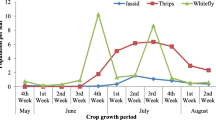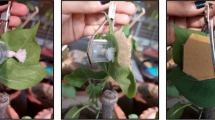Abstract
Cotton production is affected by various insect-pests attack. Among the insect pests, sucking pests impose serious crop damage. In sucking pests, the leafhopper Amrasca biguttula biguttula (Ishida), considered as a severe pest. Cultivation of susceptible hybrids and reduction in conventional insecticide applications wreak havoc of sucking pest problem. Up to 50% yield losses been reported for the pest leafhopper alone. Host plant resistance is an important component of integrated pest management strategy for leafhopper resistance. Identification of sources of resistance is way to minimize yield losses. In this study, 54 genotypes along resistant check (NDLH1938) and susceptible check (DCH32) screened for resistance in field. Based on initial resistance evaluation studies at field level, 21 genotypes were selected for further studies such as host preference studies and nymphal emergence studies in greenhouse and host plant resistance by pest infestation evaluation in field. In field screening, nine genotypes namely AKH1355, GISV 216, AKH 2012–8, GSHV 173, GISV 267, AKH 1301, GSHV 171, NDLH 2010 and AKH 2006–2 constantly showed resistance on par with resistant check (NDLH1938). Both host preference studies and nymphal emergence tests identified seven genotypes RS 2711, GISV 267, LHDP 1, AKH 1355, RS 2765, F 2164, and GISV 216, which performed on par with resistant check. Leaf anatomical parameters like distance from the lower epidermis to phloem, thickness of phloem bundle are major obstacles for stylet penetration and affect the feeding of leafhoppers. However, leaf thickness, which facilitates the insect to feed easily, succulent nature of such thick leaves preferred by the insects. Biochemical profiles revealed that higher level of chlorophyll, nitrogen, protein and amino acids favors the leafhopper infestation. In contrast, phenol compound act as feeding deterrent, as most of the resistant genotypes showed higher level of phenol.


Similar content being viewed by others
References
Agarwal RA, Banerjee SK, Katiyar KN (1978) Resistance to insects in cotton. I. To Amrasca devastans (distant). Coton Fibres Tropicales 33:409–414
Backus EA, Serrano MS, Ranger CM (2005) Mechanisms of hopperburn: an overview of insect taxonomy, behavior and physiology. Annu Rev Entomol 50:125–151
Balakrishnan N (2006) Influence of allelochemical contents in plants on the incidence of major pests of cotton. Ind J Plan Protec 34(2):202–205
Bhoge RS, Hole UB, Gangurde SM, Wagh RS (2019) Biochemical and morphological factors responsible for jassid resistance in cotton. Int J Chem Stud 7(4):166–169
Butler JGD, Wilson FD, Fishler G (1991) Cotton leaf trichomes and populations of Empoasca lybica and Bemisia tabaci. Crop Prot 10:461–464
Deguine JP, Hau B (2001) The influence of the plant on Aphis gossypii. Some results of research conducted in Cameroon. In: Gourlot JP, Drych R (eds) Improvement of the Marketability of Cotton Produced in Zones Affected by Stickiness. Actes du Séminaire, 4–7 Juillet 2001, Lille, France. Technical report, CIRAD, Montpellier
Eittipibool W, Renou A, Chongrattanameteekul W, Hormchan P (2001) Effects of cotton growth regulator on jassid infestation and injury. Kasetsart J (Nat Sci) 35:378–385
Febvay G, Rahbe Y, Rynkiewicz M, Guillard J, Bonnot G (1999) Fate of dietary sucrose and neosynthesis of amino acids in the pea aphid, Acyrthosiphon pisum, reared on different diets. J Exp Biol 19:2639–2652
Harijan Y, Nishanth GK, Katageri IS, Khadi BM, Patil BR (2017) Biochemical and anatomical factors imparting resistance against sucking pests in cotton. Int J Curr Microbiol App Sci 6(7):2542–2553
Hosagoudar GN, Chattannavar SN (2009) Biochemical studies in cotton line having differential reaction of grey mildew (Ramularia areola Atk.). Karnataka J Agric Sci 22(2):331–335
ISAAA (2018) Global Status of Commercialized Biotech/GM Crops: 2018. ISAAA Brief No.54. ISAAA, Ithaca
Jensen WA (1962) Botanical histochemistry principles and practice. W.H. Freeman and Co, San Francisco
Jindal V, Dhaliwal GS, Dhawan AK (2008) International mechanisms of resistance in cotton to whitefly Bemisia tabaci (Homoptera: Aleyrodidae): antibiosis. J Trop Insect Sci 27(3&4):216–222
Kadapa SN, Vizia NC, Patil NB (1988) A note on stem tip stiffness in aphid tolerant cotton Gossypium hirsutum L. Curr Sci 57:265–266
Kalkal D, Dahiya KK, Lal R (2009) Impact analysis of genetically modified (Bt) cotton cultivars on natural enemies. J Cotton Res Dev 23(1):111–116
Kanher FM, Syed TS, Abro GH, Jahangir M, Tunio SA (2016) Some Physio morphological leaf characters of gamma irradiated cotton lines to resistance against Jassid (Amrasca Devastans Dist.). J Entomol Zool Stud 4(3):80–85
Khan ZR, Agarwal RA (1984) Ovipositional preference of jassid, Amrasca biguttula biguttula Ishida on cotton. J Entomol Res 8:78–80
Khan ZR, Saxena RC (1998) Host plant resistance to insects. In: Dhaliwal GS, Heinrichs EA (eds) Critical issues in Insect Pest Management. Commonwealth Publishers, New Delhi, pp 118–154
Kranthi S (2017) Forty years of cotton crop protection in India. Cotton Stat News 18:3
Mahal MS, Lal H, Singh R, Singh B (1993) Field resistance in okra to the cotton jassid in relation to crop age. J Insect Sci 6(1):60–63
Maite RK, Bidinger FR, Sheshu Reddy KV, Davies JC (1980) Nature of occurrence of trichomes in sorghum lines with resistance to sorghum shoot fly. Joint progress rep. Sorghum physiology-3.SorghumEntomology-3.ICRISAT, Patancheru, Hyderabad
Manish NR (1998) A study on the management of leafhopper, Amrasca devastans (distant) in cotton. M.Sc. (Ag.) thesis. TNAU, Killikulam
Manivannan A, Philip Sridhar R, Karthikeyan S, Kuzhandhaivel PA (2017) Screening of cotton genotypes against leafhopper, Amrasca biguttula biguttula (Ishida) (Homoptera: Cicadellidae). J Entomol Zool 5(6):1305–1310
Maxwell PG, Jennings PR (eds) (1980) Breeding plants resistance to insects. John Wiley and Sons, New York, p 683
Meagher RL, Smith CW, Smith WJ (1997) Preference of Gossypium line to Bemisia argentifolii (Homoptera: Aleyrodidae). J Econ Entomol 90(4):1046–1052
Mohankumar S (1996) Integration of plant resistance with insecticides for the management of cotton leafhopper, Amrasca devastans (Disant). Ph.D., Thesis, Tamil Nadu Agricultural University, Coimbatore. P. 256
Moore S, Stein WH (1948) Photometric ninhydrin method for use in chromatography of amino acids. J Biol Chem 176:367–388
Muhammad N, Anjum ZI, Khan JA, Rafiq M, Hamza A (2011) Cotton genotypes morpho-physical factors affect resistance against Bemisia tabaci in relation to other sucking pests and its associated predators and parasitoids. Pak J Zool 43(2):229–236
Murugesan N, Kavitha A (2010) Host plant resistance in cotton accessions to the leafhopper, Amrasca devastans (distant). J Biopesticides 3(3):526–533
Murugesan N, Vimala R, Ramalingam A, Shunmugavalli N (2009) Evaluation of an IPM module against insect pests of cotton with Bt and Non-Bt cotton hybrids. Paper presented in Conference on Recent Advances in Applied Zoology, March 30th & 31st, 2009 at ANJAC, Sivakasi. PP 44–45
Nibouche S, Brévault T, Klassou C, Dessauw D, Hau B (2008) Assessment of resistance of cotton germplasm (Gossypium spp.) to aphids (Homoptera: Aphididae) and leafhoppers (Homoptera: Cicadellidae: Typhlocybinae): methodology and genetic variability. Plant Breed 127:376–382
Nielsen GR, Lamp WO, Stutte GW (1990) Potato leafhopper (Homoptera: Cicadellidae) feeding disruption of phloem translocation in alfalfa. J Econ Entomol 83:807–813
Osawaru ME, Dania-Ogbe FM, Chime AO, Ogwu MC (2011) Epidermal morphology of west african okra (Abelmoschus caillei (a. Chev.) stevels) from south western Nigeria. Sci World J 6:15–23
Painter RH (1968) Insect resistance in crop plants. The University Press of Kansas, London
Parnell FR, King HE, Ruston DF (1949) Jassid resistance and hairiness of the cotton plant. Bull Entomol Res 39:539–575
Prabhakar M, Prasad YG, Thirupathi M, Sreedevi G, Dharajothi B, Venkateswarlu B (2011) Use of ground based hyperspectral remote sensing for detection of stress in cotton caused by leafhopper (Hemiptera: Cicadellidae). Comput Electron Agric 79:189–198
Rana MY, Manzoor A (2003) Relative resistance of some cotton cultivars against insect pests with reference to physico-chemical characters. Pak J Agric Sci 27(4):409
Rohini A, Prasad NVVSD, Chalam MSV, Veerairah K (2011) Identification of suitable resistant cotton genotypes against sucking pests. J Ent Res 35(3):197–202
Rustamani MA, Khatri I, Leghari MH, Sultana R, Mandokhail AS (2014) Trichomes of cotton leaf as an aspect of resistance to sucking insect pests. Sindh Univ Res J (Sci Ser) 46:351–356
Sadasivam S, Manickam A (1992) Biochemical methods for agricultural sciences, pp. 12–13
Schaller A (2008) Induced plant resistance to herbivory. In: Bernards, MA, Bastrup-Spohr L (eds) Phenypropanoid metabolism induced by wounding and insect herbivory. Springer, New York, pp 189–208
Shaheen N, Khan MA, Yasmin G, Ahmad M, Mahmood T, Hayat MQ, Zafa M (2009) Foliar epidermal anatomy and its systematic implication within the genus. Afr J Biotechnol 8:5328–5336
Singh R, Agarwal RA (1988) Role of chemical components of resistant and susceptible genotypes of cotton and okra in ovipositional preference of cotton leafhopper. Proc Anim Sci 97(6):545–550
Singh M, Lal CB (1993) Breeding for resistance to jassid and bollworms(Earias spp.) in Egyptian cotton. Indian J Agric Sci 63:547–550
Taylo LD, Bernardo EN (1995) Morphological and biochemical bases of resistance of eggplant (Solanum melongena Linn.) and okra (Abelmoschus esculentus (L.) Moench.) to cotton leafhopper (Amrasca biguttula (Ishida)). Pest management Council of the Philippines, Inc., college, Laguna (Philippines). PMCP 26th anniversary and annual scientific meeting, p. 78-79
Traw BM, Dawson TE (2002) Reduced performance of herbivores Lepidoptera: Pieridae, Coleoptera: Chrysomelidae on new leaves of damaged black mustard plants. Environ Entomol 31:714–722
Uthamasamy S (1985) Influence of leaf hairiness on the resistance of bhendi or lady’s finger, (Abelmoschus esculentus) (L.) Moench to the leafhopper, Amrasca devastans (distant). Trop Pest Manag 31:194–295
Uthamasamy S, Subramanian TR, Jayaraj S (1971) Studies on plant characters of bhindi associated with resistance to leafhopper. Progress Hortic 3:25–32
War ARW, Paulray MG, Ahmad T, Buhroo AA, Hussain B, Ignacimuthu S et al (2012) Mechanisms of plant defense against insect herbivores. Plant Signal Behav 7:1306–1320
Wu KM, Guo YY (2005) The evolution of cotton pest management practices in China. Annu Rev Entomol 50:31–52
Acknowledgments
Authors wish to acknowledge ICAR-CICR for providing necessary support to carry out this research work.
Author information
Authors and Affiliations
Corresponding author
Ethics declarations
Conflict of interest
The authors declare that they have no conflict of interest.
Additional information
Publisher’s note
Springer Nature remains neutral with regard to jurisdictional claims in published maps and institutional affiliations.
Rights and permissions
About this article
Cite this article
Manivannan, A., Kanjana, D., Dharajothi, B. et al. Evaluation of resistance in cotton genotypes against leafhoppers Amrasca biguttula biguttula (Ishida), (Homoptera: Cicadellidae). Int J Trop Insect Sci 41, 2409–2420 (2021). https://doi.org/10.1007/s42690-020-00416-0
Received:
Accepted:
Published:
Issue Date:
DOI: https://doi.org/10.1007/s42690-020-00416-0




